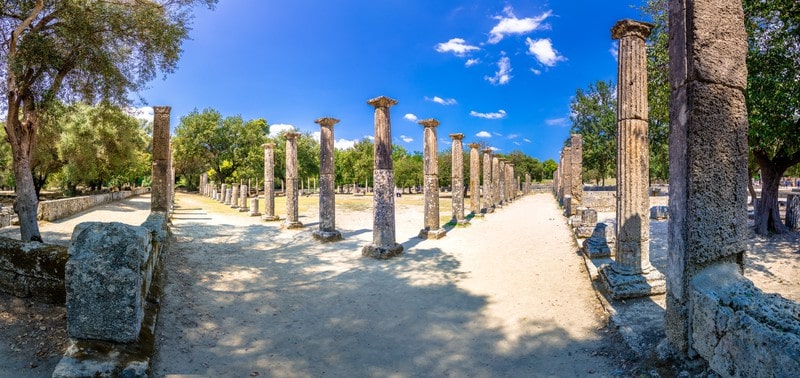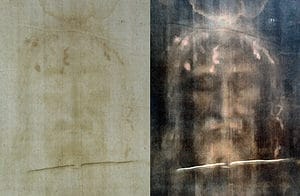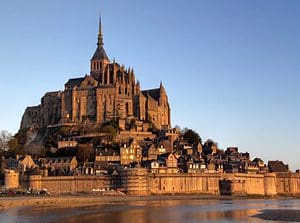The Zeus statue in Olympia was one of the Seven Wonders of the Ancient World. It was built in 466-456 BC by the artist Phidias. The completed statue was consecrated ca. 430 BCE. It was moved to Constantinople in the fourth century and was destroyed in a major city fire in 462 AD.
What is special about the Statue of Zeus?
The statue of the mighty Zeus was over 13 m high and depicted the god sitting on a throne.
The statue was larger than Athena Parthenos in Athens, which was also designed by Phidias. The Zeus statue, like Athena, was chryselephantine. This is an engineering term for a construction technique of combining gold and ivory over a wooden core. The skin of the god (face, torso, arms and legs) was made of ivory plates and gold was used for his beard, robes and staff.
The fine details were worked out using a wide range of materials: silver, copper, glass, ebony, enamel, paint and jewelry.

The clay forms discovered in Phidias’ workshop for a similar statue suggest that it was first erected there in pieces (the size of the workshop is exactly the same dimensions as the temple at Olympia) and then assembled at its final destination.
The statue was placed in the center of the temple in a way that when the doors were opened, it could look out on the sacrifices, ceremonies and games performed outside in honor of Zeus. The statue was so impressive that the ancient Greeks considered it one of the seven wonders of the ancient world.
How do we know how the Zeus statue looked?
The most complete description of the sculpture from ancient sources is found in the Description of Greece by the Greek geographer and traveler Pausanias from the 2nd century AD.

Pausanius wrote:
“The god sits on a throne and he is made of gold and ivory. On his head is a garland that is a copy of olive shoots. In his right hand he carries a Victory [Nike], which, like the statue, is of ivory and gold… In his left hand he carries a scepter, decorated with various metals, and the bird that sits on the scepter is an eagle. The god’s sandals are also made of gold, as is his robe. On the robe are embroidered figures of animals and the flowers of the lily. The throne is decorated with gold and with jewels, not to mention ebony and ivory. On it are painted figures and carved images.”
The figure of Zeus, throne and stool, was placed on a pedestal of black Eleusinian marble, measuring 9.93 x 6.25 meters. The base was decorated with scenes of the birth of Aphrodite. The pedestal was signed with the words “Phidias, the son of Charmides, an Athenian, made me.”
The statue stood before a shallow pool of diluted or pure olive oil to maintain a humid atmosphere. The reflection of the statue in the oil, must have complemented the mystical appearance of the representation.
Who was Zeus?
The most essential function of Zeus is that of sky god. Nature and all her phenomena were subject to him. He threw lightning, gathered the clouds and drove them apart; rain and snowfall were caused by him.
High mountains were his abodes: the Ida in Crete, the Lycaeus in Arcadia, but the most famous is the Olympus in Thessaly.
The eagle (originally a symbol of lightning) was his sacred bird, the oak his sacred tree. By bringing about lightning and thunder, but also with a rainbow and the flight of birds, Zeus gave omens to man.
At the oracle of Dodona, the priests could learn the will of Zeus by listening to the rustling of the oaks in the sacred oak forest dedicated to Zeus.
Zeus' story
Zeus’ father, Cronos, had defeated the sky god Uranus (also known as Ouranos). Uranus warned him that Cronos would be dethroned by his son. Thereupon, Cronos decided to devour all his children immediately after birth.

When Zeus was born, Cronos’ wife Rhea, quickly wrapped him in a cloth and gave the child to Gaea. Then she gave Cronos the stone to eat. Zeus was hidden by Gaea in a cave where he is suckled by Amaltheia – a creature that was both a goat and a nymph.
Years later, Zeus heard about the injustice done to his father Rhea, and he vowed revenge for the killing of his siblings. The god ordered his first wife, Metis, to give Cronos an emetic.
After that, Cronos first vomits out the stone he mistook for Zeus and then his siblings also appear. They are so happy that they immediately join their youngest brother to remove Cronos from his throne.
After the victory over his father, Zeus divides the world between himself and his brothers. From then on, he himself rules the heavens, while his brothers Hades and Poseidon are given dominion over the underworld and the sea.

Zeus played a major role in many Greek myths and sagas. Several of these stories revolve around the many mortal and immortal mistresses the god had, much to the displeasure of his jealous wife Hera who regularly took revenge on her husband’s lovers.
Zeus Trivia
The equivalent of Zeus in Roman religion is Jupiter. This is also the planet named after him. Astrologically, this planet is associated with the principles of growth, expansion, healing, prosperity, good fortune, and miracles. The corresponding astrological sign is:
The symbols of Zeus are the lightning bolt, the eagle, the bull and the oak tree.
Olympia
In the western Peloponnese, in the so-called “valley of the gods,” ancient Olympia grew to become the most celebrated sacred site of ancient Greece.
It became the birthplace of the Olympic Games, the most important sporting event of antiquity.
Starting in 776 BC, all Greeks in the then-known world would be united every four years to play sports. All hostilities would be suspended so that everyone could participate in these games in the true spirit.

The Temple of Zeus was the largest and most important building in Olympia and one of the largest Doric temples in Greece. It was located in an area that was also called the Sacred Forest of Zeus. This area was bounded on the north by the hill Cronos and on the other sides were standing walls.
There were buildings used by the priests (Theokoleon)and for administration (Bouleuterion). There were also residences for distinguished guests (the House of Nero) and all the sports structures used for the preparation and celebration of the Olympic Games, such as the stadium and hippodrome in the east, and the thermal baths, palaestra, and gymnasium in the south and west.

At this time, Olympia is one of the most interesting places to visit if you are on the Peloponnesus. Of course, you buy a ticket in advance so you don’t have to wait in line to get in. The tour using virtual reality is fantastic.
Staying near Olympia
If you want to stay in this beautiful area I can really recommend the very best hotel in the area. Hotel Europa Olympia has great staff and a delicious full breakfast. The hotel’s restaurant is a great place to eat, while enjoying the sunset overlooking the impressive valley.
You can also enter the dates below for your stay to see what other hotels are available at booking.com









